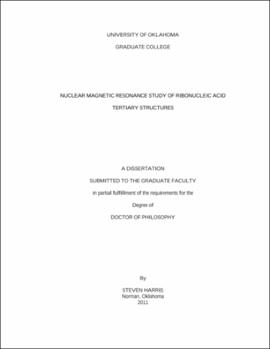| dc.contributor.advisor | Schroeder, Susan J | |
| dc.creator | Harris, Steven M. | |
| dc.date.accessioned | 2019-04-27T21:22:15Z | |
| dc.date.available | 2019-04-27T21:22:15Z | |
| dc.date.issued | 2011 | |
| dc.identifier | 99133475802042 | |
| dc.identifier.uri | https://hdl.handle.net/11244/318518 | |
| dc.description.abstract | Ribonucleic acid (RNA) is ubiquitous to all organisms and a molecule that essential to all life forms. RNA is a versatile molecule with numerous cellular functions. With advances in nucleic acid sequencing, researchers are finding that there is an increasing number of RNAs that participate in non-coding cellular roles. The most logical means of discerning the function of these RNAs is to exploit the structure-function relationship that exists. The three-dimensional structure of RNA holds a wealth of information that gives insight into its molecular functioning scheme. | |
| dc.description.abstract | At this present time, the most common methods of solving the tertiary structure of RNA is x-ray crystallography and nuclear magnetic resonance spectroscopy. These two methods are very time consuming. If tertiary structures could be predicted from sequence, this would relieve the bottleneck in determine the function of RNAs. From the tertiary structure, better hypotheses could be formulated and less experimental work would need to be done to verify them. | |
| dc.description.abstract | Tertiary structure prediction of RNA is progressing but there is still room for improvement. Since prediction programs can predict Watson-Crick base pairs well, improvements must focus mainly on interactions involving non-canonical or unpaired bases. There is much more information to be learned from tertiary structures that will help improve the current prediction programs. Therefore, solving tertiary structures of RNA is of extreme importance in order to better the prediction ability from sequence. | |
| dc.description.abstract | This research presents the tertiary structure of two RNA sequences. The first is a RNA hairpin, which is one of the most common RNA secondary structures. Hairpins are believed to aid in the folding of large RNA and sometimes help keep the molecule from falling into kinetic traps. If this happens, the RNA molecule is usually in a non-functional state and is rendered useless. Improving our ability to predict hairpins will essentially help improve the prediction of larger molecules as well. This hairpin is a part of a nanomolecular motor that is used by a phage and incorporates the genome back into an empty viral capsid. | |
| dc.description.abstract | The Bacillus subtilis phage phi29 packaging motor requires prohead RNA for genome encapsidation. The NMR structure of the prohead RNA E-loop hairpin, r(5'AUUGAGUU), and MC-SYM predictions for prohead RNA E-loops provide a basis for comparative analysis of hairpin structures in prohead and ribosomal RNA. All the hairpins contain a U-turn motif but differ in the first non-canonical pair and backbone orientation. These structures provide benchmarks for further improvements in RNA structure predictions from sequence as well as provide the first piece of structural information about the phi29 pRNA molecule. | |
| dc.description.abstract | G-U base pairs are the most common non-canonical base pairs. They have been found to be conserved throughout numerous phylogenetic alignments and have been proven to be more than simply replacements for Watson-Crick base pairs. The tertiary structure that is presented in this research is a self-complimentary duplex 5'r(GUGUCGGUGU)2 and is the first NMR solution structure with consecutive terminal G-U pairs. The stability of G-U pairs is variable depending on where they are in the sequence. In the center of a duplex, they have been found to be destabilizing to the helix. On the ends of helices, they have been found to be thermodynamically stabilizing to the duplex. The tertiary structure of the duplex was found to be nearly A-form. This is a surprising result because it is comprised of mostly non-canonical base pairs. The helical parameters of the solution structure were then compared to those of internal G-U pairs to pinpoint the differences in base interactions and provide a hypothesis for the differences in stabilities of internal versus terminal G-U pairs. It was found that the internal parameters are, in fact, different from the terminal G-U pairs. These results were then compared to the helical parameters of the structure predicted by the tertiary structure prediction program, MC-SYM. Results show that the prediction has helical parameters that matched the trends seen for internal G-U base pairs even though the solution structure did not. This prediction results are not surprising since there were no previous solution structures containing consecutive terminal G-U base pairs. These results also show the importance of solving the tertiary structures of duplexes such as this in order to aid in the diversification of the databank of known tertiary structures. | |
| dc.format.extent | 148 pages | |
| dc.format.medium | application.pdf | |
| dc.language | en_US | |
| dc.relation.requires | Adobe Acrobat Reader | |
| dc.subject | RNA | |
| dc.subject | Nuclear magnetic resonance | |
| dc.subject | Nucleotide sequence | |
| dc.title | Nuclear Magnetic Resonance Study of Nucleic Acid Tertiary Structures | |
| dc.type | text | |
| dc.type | document | |
| dc.thesis.degree | Ph.D. | |
| ou.group | College of Arts and Sciences::Department of Chemistry and Biochemistry | |
